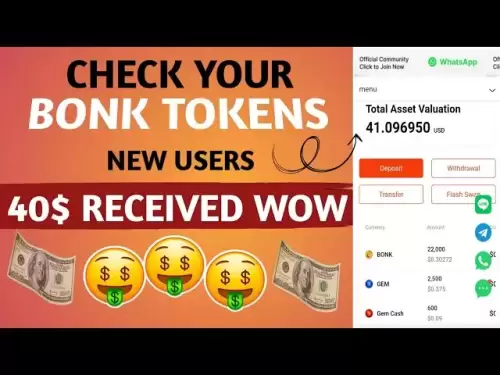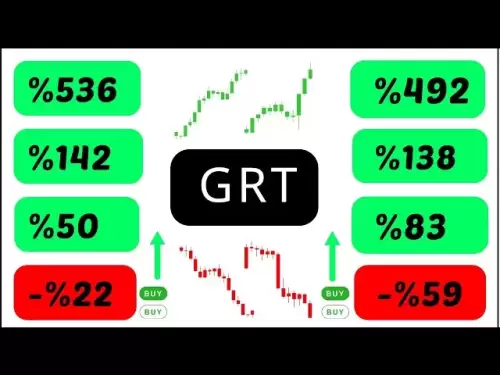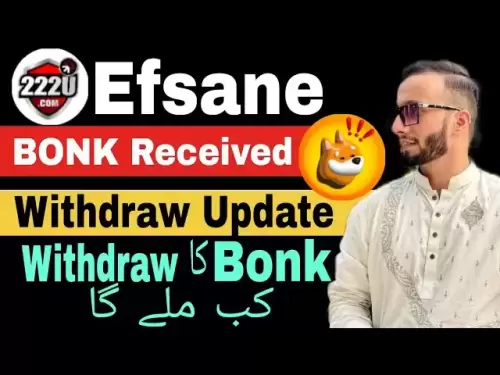-
 Bitcoin
Bitcoin $107,467.9126
1.26% -
 Ethereum
Ethereum $2,447.5288
-0.12% -
 Tether USDt
Tether USDt $1.0005
0.00% -
 XRP
XRP $2.1921
0.13% -
 BNB
BNB $647.2897
0.50% -
 Solana
Solana $144.8627
-0.37% -
 USDC
USDC $0.9996
-0.03% -
 TRON
TRON $0.2732
0.10% -
 Dogecoin
Dogecoin $0.1652
-0.18% -
 Cardano
Cardano $0.5700
-2.87% -
 Hyperliquid
Hyperliquid $37.0274
-1.81% -
 Bitcoin Cash
Bitcoin Cash $484.6957
0.19% -
 Sui
Sui $2.7354
-2.19% -
 Chainlink
Chainlink $13.1727
-1.49% -
 UNUS SED LEO
UNUS SED LEO $8.9978
-0.04% -
 Stellar
Stellar $0.2421
-2.33% -
 Avalanche
Avalanche $17.5633
-3.51% -
 Toncoin
Toncoin $2.8476
-1.94% -
 Shiba Inu
Shiba Inu $0.0...01166
-0.56% -
 Litecoin
Litecoin $85.1071
0.09% -
 Hedera
Hedera $0.1502
-2.96% -
 Monero
Monero $310.2774
-1.64% -
 Dai
Dai $0.9999
-0.01% -
 Polkadot
Polkadot $3.3584
-1.88% -
 Ethena USDe
Ethena USDe $1.0003
-0.04% -
 Bitget Token
Bitget Token $4.4443
2.90% -
 Pi
Pi $0.6242
14.04% -
 Uniswap
Uniswap $6.9774
-2.86% -
 Pepe
Pepe $0.0...09535
-5.05% -
 Aave
Aave $256.7574
-3.35%
What are the risks of Maker (MKR) trading? How to avoid market manipulation?
Trading MKR involves risks like market volatility, liquidity issues, and regulatory changes; traders should use stop-loss orders and monitor for manipulation to safeguard investments.
May 06, 2025 at 11:56 am

Trading Maker (MKR), like any cryptocurrency, comes with a variety of risks that traders must be aware of to protect their investments. Understanding these risks and learning how to mitigate them can help traders navigate the volatile crypto market more safely. Additionally, market manipulation is a significant concern in the cryptocurrency space, and understanding how to avoid falling victim to it is crucial.
Understanding the Risks of Maker (MKR) Trading
Trading MKR involves several inherent risks. Market volatility is one of the most prominent risks. Cryptocurrency markets are known for their rapid price fluctuations, which can lead to significant gains or losses in a short period. For MKR, this volatility can be particularly pronounced due to its role in the decentralized finance (DeFi) ecosystem.
Liquidity risk is another factor to consider. MKR might not always have the same level of liquidity as more established cryptocurrencies like Bitcoin or Ethereum. Lower liquidity can result in larger spreads between buying and selling prices, making it more difficult to execute trades at desired prices.
Regulatory risk is also a concern. The regulatory environment for cryptocurrencies is constantly evolving, and changes in regulations can impact the value and legality of trading MKR. Traders need to stay informed about regulatory developments in their jurisdiction and how they might affect their trading activities.
Identifying Market Manipulation in MKR Trading
Market manipulation is a serious issue in the cryptocurrency market, and MKR trading is no exception. Pump and dump schemes are one of the most common forms of market manipulation. In these schemes, manipulators artificially inflate the price of a cryptocurrency by spreading positive rumors or using bots to buy large volumes, only to sell off their holdings once the price peaks, leaving other investors with losses.
Spoofing is another type of manipulation where traders place large orders to create a false impression of market demand or supply, only to cancel these orders before they are executed. This can mislead other traders into making decisions based on the false market signals.
Wash trading involves a trader buying and selling the same asset to create the appearance of higher trading volume. This can deceive other traders into thinking there is more interest in MKR than there actually is, potentially leading them to make poor trading decisions.
Strategies to Avoid Market Manipulation
To protect yourself from market manipulation while trading MKR, it is essential to conduct thorough research. Always verify information from multiple reputable sources before making trading decisions. Be wary of sudden spikes in price or volume that are not supported by fundamental changes in the project or market conditions.
Using reputable exchanges is another crucial step. Established exchanges with strong anti-manipulation measures in place are less likely to be venues for manipulative activities. Look for exchanges that have clear policies against market manipulation and actively monitor trading activities.
Diversifying your portfolio can also help mitigate the risks of market manipulation. By not putting all your funds into MKR or any single cryptocurrency, you reduce the impact that manipulation in one market can have on your overall investment.
Practical Steps to Safeguard Your MKR Trading
To further protect your investments, consider the following practical steps:
Set stop-loss orders: These can help limit your losses by automatically selling your MKR if the price falls to a certain level. To set a stop-loss order:
- Log into your trading platform.
- Navigate to your MKR holdings.
- Select the option to set a stop-loss order.
- Enter the price at which you want the order to trigger.
- Confirm the order.
Use limit orders: Instead of market orders, use limit orders to buy or sell MKR at a specific price. This can help you avoid buying at artificially inflated prices or selling at artificially depressed prices. To set a limit order:
- Access your trading platform.
- Go to the MKR trading section.
- Choose to place a limit order.
- Specify the price at which you want to buy or sell.
- Confirm the order.
Monitor trading volumes and price movements: Keep an eye on unusual patterns in trading volumes and price movements. Tools like trading charts and volume indicators can help you identify potential manipulation.
Stay informed about MKR and the broader crypto market: Regularly read news and updates from official MKR sources and reputable crypto news outlets. This can help you stay ahead of market trends and potential manipulation schemes.
Utilizing Technical Analysis for MKR Trading
Technical analysis can be a valuable tool for MKR traders looking to avoid market manipulation. By studying price charts and using technical indicators, traders can identify patterns and trends that may indicate manipulation. Moving averages, Relative Strength Index (RSI), and Bollinger Bands are some of the technical indicators that can help you make more informed trading decisions.
To use technical analysis effectively:
- Choose a reliable charting platform: Platforms like TradingView or Coinigy offer robust charting tools for analyzing MKR price movements.
- Learn to read charts: Understand how to interpret candlestick patterns, support and resistance levels, and other chart elements.
- Apply technical indicators: Add indicators like moving averages or RSI to your charts to help identify potential manipulation.
Building a Risk Management Plan
A comprehensive risk management plan is essential for any MKR trader. Define your risk tolerance and set clear goals for your trading activities. Determine how much of your portfolio you are willing to risk on MKR and stick to that allocation.
Regularly review your trading strategy to ensure it aligns with your risk management plan. Adjust your strategy as needed based on market conditions and your performance. Keep detailed records of your trades to analyze your successes and failures and refine your approach over time.
Frequently Asked Questions
Q: How can I tell if MKR is being manipulated?
A: Look for sudden, unexplained spikes in price or trading volume, especially if they are not supported by news or developments related to MKR. Use technical analysis tools to identify unusual patterns that may indicate manipulation.
Q: Is it safe to trade MKR on decentralized exchanges?
A: Trading MKR on decentralized exchanges (DEXs) can be safer in terms of avoiding centralized exchange risks like hacking. However, DEXs may have lower liquidity and could still be susceptible to market manipulation. Always do your due diligence before trading on any platform.
Q: Can I report market manipulation if I suspect it?
A: Yes, if you suspect market manipulation, you can report it to the exchange where you are trading. Many exchanges have mechanisms for reporting suspicious activities. Additionally, you can report to regulatory bodies in your jurisdiction, although their ability to intervene may vary.
Q: How does the role of MKR in the MakerDAO ecosystem affect its trading risks?
A: MKR is used to govern the MakerDAO protocol, which includes managing the DAI stablecoin. Changes in the governance of MakerDAO or issues with the DAI peg can impact MKR's price and trading risks. Traders should stay informed about MakerDAO developments to better understand these risks.
Disclaimer:info@kdj.com
The information provided is not trading advice. kdj.com does not assume any responsibility for any investments made based on the information provided in this article. Cryptocurrencies are highly volatile and it is highly recommended that you invest with caution after thorough research!
If you believe that the content used on this website infringes your copyright, please contact us immediately (info@kdj.com) and we will delete it promptly.
- Pi Coin Price Prediction: June 26 - Will It Break $0.70?
- 2025-06-26 09:05:13
- Tokenization Takes Flight: Cross-Border Transactions Soar to New Heights
- 2025-06-26 08:30:12
- Midnight Airdrop: NIGHT Tokens and the Cardano-XRP Connection
- 2025-06-26 08:50:13
- DRML Miner & USDC: Cloud Mining Revolution in '25
- 2025-06-26 09:05:13
- DRML Miner, USDC, and Cloud Mining: What's the Buzz in 2025?
- 2025-06-26 09:30:12
- Barclays, Crypto, and Credit Cards: A Shifting Landscape
- 2025-06-26 09:10:14
Related knowledge

How to customize USDT TRC20 mining fees? Flexible adjustment tutorial
Jun 13,2025 at 01:42am
Understanding USDT TRC20 Mining FeesMining fees on the TRON (TRC20) network are essential for processing transactions. Unlike Bitcoin or Ethereum, where miners directly validate transactions, TRON uses a delegated proof-of-stake (DPoS) mechanism. However, users still need to pay bandwidth and energy fees, which are collectively referred to as 'mining fe...

USDT TRC20 transaction is stuck? Solution summary
Jun 14,2025 at 11:15pm
Understanding USDT TRC20 TransactionsWhen users mention that a USDT TRC20 transaction is stuck, they typically refer to a situation where the transfer of Tether (USDT) on the TRON blockchain has not been confirmed for an extended period. This issue may arise due to various reasons such as network congestion, insufficient transaction fees, or wallet-rela...

How to cancel USDT TRC20 unconfirmed transactions? Operation guide
Jun 13,2025 at 11:01pm
Understanding USDT TRC20 Unconfirmed TransactionsWhen dealing with USDT TRC20 transactions, it’s crucial to understand what an unconfirmed transaction means. An unconfirmed transaction is one that has been broadcasted to the blockchain network but hasn’t yet been included in a block. This typically occurs due to low transaction fees or network congestio...

How to check USDT TRC20 balance? Introduction to multiple query methods
Jun 21,2025 at 02:42am
Understanding USDT TRC20 and Its ImportanceUSDT (Tether) is one of the most widely used stablecoins in the cryptocurrency market. It exists on multiple blockchain networks, including TRC20, which operates on the Tron (TRX) network. Checking your USDT TRC20 balance accurately is crucial for users who hold or transact with this asset. Whether you're sendi...

What to do if USDT TRC20 transfers are congested? Speed up trading skills
Jun 13,2025 at 09:56am
Understanding USDT TRC20 Transfer CongestionWhen transferring USDT TRC20, users may occasionally experience delays or congestion. This typically occurs due to network overload on the TRON blockchain, which hosts the TRC20 version of Tether. Unlike the ERC20 variant (which runs on Ethereum), TRC20 transactions are generally faster and cheaper, but during...

The relationship between USDT TRC20 and TRON chain: technical background analysis
Jun 12,2025 at 01:28pm
What is USDT TRC20?USDT TRC20 refers to the Tether (USDT) token issued on the TRON blockchain using the TRC-20 standard. Unlike the more commonly known ERC-20 version of USDT (which runs on Ethereum), the TRC-20 variant leverages the TRON network's infrastructure for faster and cheaper transactions. The emergence of this version came as part of Tether’s...

How to customize USDT TRC20 mining fees? Flexible adjustment tutorial
Jun 13,2025 at 01:42am
Understanding USDT TRC20 Mining FeesMining fees on the TRON (TRC20) network are essential for processing transactions. Unlike Bitcoin or Ethereum, where miners directly validate transactions, TRON uses a delegated proof-of-stake (DPoS) mechanism. However, users still need to pay bandwidth and energy fees, which are collectively referred to as 'mining fe...

USDT TRC20 transaction is stuck? Solution summary
Jun 14,2025 at 11:15pm
Understanding USDT TRC20 TransactionsWhen users mention that a USDT TRC20 transaction is stuck, they typically refer to a situation where the transfer of Tether (USDT) on the TRON blockchain has not been confirmed for an extended period. This issue may arise due to various reasons such as network congestion, insufficient transaction fees, or wallet-rela...

How to cancel USDT TRC20 unconfirmed transactions? Operation guide
Jun 13,2025 at 11:01pm
Understanding USDT TRC20 Unconfirmed TransactionsWhen dealing with USDT TRC20 transactions, it’s crucial to understand what an unconfirmed transaction means. An unconfirmed transaction is one that has been broadcasted to the blockchain network but hasn’t yet been included in a block. This typically occurs due to low transaction fees or network congestio...

How to check USDT TRC20 balance? Introduction to multiple query methods
Jun 21,2025 at 02:42am
Understanding USDT TRC20 and Its ImportanceUSDT (Tether) is one of the most widely used stablecoins in the cryptocurrency market. It exists on multiple blockchain networks, including TRC20, which operates on the Tron (TRX) network. Checking your USDT TRC20 balance accurately is crucial for users who hold or transact with this asset. Whether you're sendi...

What to do if USDT TRC20 transfers are congested? Speed up trading skills
Jun 13,2025 at 09:56am
Understanding USDT TRC20 Transfer CongestionWhen transferring USDT TRC20, users may occasionally experience delays or congestion. This typically occurs due to network overload on the TRON blockchain, which hosts the TRC20 version of Tether. Unlike the ERC20 variant (which runs on Ethereum), TRC20 transactions are generally faster and cheaper, but during...

The relationship between USDT TRC20 and TRON chain: technical background analysis
Jun 12,2025 at 01:28pm
What is USDT TRC20?USDT TRC20 refers to the Tether (USDT) token issued on the TRON blockchain using the TRC-20 standard. Unlike the more commonly known ERC-20 version of USDT (which runs on Ethereum), the TRC-20 variant leverages the TRON network's infrastructure for faster and cheaper transactions. The emergence of this version came as part of Tether’s...
See all articles
























































































